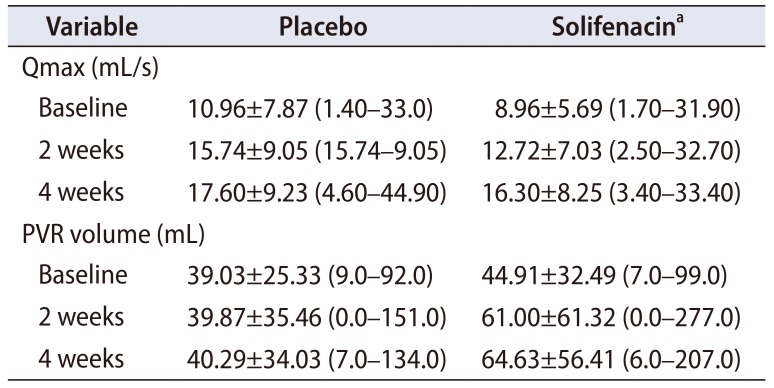1. Yeo JK, Choi H, Bae JH, Kim JH, Yang SO, Oh CY, et al. Korean clinical practice guideline for benign prostatic hyperplasia. Investig Clin Urol. 2016; 57:30–44.
2. Mandeville J, Mourtzinos A. Surgical management of male voiding dysfunction. Surg Clin North Am. 2016; 96:491–501. PMID:
27261790.

3. Nitti VW, Kim Y, Combs AJ. Voiding dysfunction following transurethral resection of the prostate: symptoms and urodynamic findings. J Urol. 1997; 157:600–603. PMID:
8996367.

4. Abrams PH, Farrar DJ, Turner-Warwick RT, Whiteside CG, Feneley RC. The results of prostatectomy: a symptomatic and urodynamic analysis of 152 patients. J Urol. 1979; 121:640–642. PMID:
86617.

5. Gormley EA, Griffiths DJ, McCracken PN, Harrison GM, McPhee MS. Effect of transurethral resection of the prostate on detrusor instability and urge incontinence in elderly males. Neurourol Urodyn. 1993; 12:445–453. PMID:
7504554.

6. Hyman MJ, Groutz A, Blaivas JG. Detrusor instability in men: correlation of lower urinary tract symptoms with urodynamic findings. J Urol. 2001; 166:550–552. PMID:
11458066.

7. Housami F, Abrams P. Persistent detrusor overactivity after transurethral resection of the prostate. Curr Urol Rep. 2008; 9:284–290. PMID:
18765127.

8. Kageyama S, Watanabe T, Kurita Y, Ushiyama T, Suzuki K, Fujita K. Can persisting detrusor hyperreflexia be predicted after transurethral prostatectomy for benign prostatic hypertrophy? Neurourol Urodyn. 2000; 19:233–240. PMID:
10797580.

9. Zhao YR, Liu WZ, Guralnick M, Niu WJ, Wang Y, Sun G, et al. Predictors of short-term overactive bladder symptom improvement after transurethral resection of prostate in men with benign prostatic obstruction. Int J Urol. 2014; 21:1035–1040. PMID:
24825248.

10. YI Q, Gong M, Hu W, Tian B, Zhu F, Wang T, et al. Efficacy of solifenacin in the treatment of overactive bladder syndrome after transurethral resection of the prostate. Chin J Urol. 2011; 32:415–418.
11. Tanaka Y, Masumori N, Itoh N, Furuya S, Ogura H, Tsukamoto T. Is the short-term outcome of transurethral resection of the prostate affected by preoperative degree of bladder outlet obstruction, status of detrusor contractility or detrusor overactivity? Int J Urol. 2006; 13:1398–1404. PMID:
17083391.

12. Antunes AA, Iscaife A, Reis ST, Albertini A, Nunes MA, Lucon AM, et al. Can we predict which patients will experience resolution of detrusor overactivity after transurethral resection of the prostate? J Urol. 2015; 193:2028–2032. PMID:
25583645.

13. Jeong SJ, Lee SC, Jeong CW, Hong SK, Byun SS, Lee SE. Clinical and urodynamic differences among women with overactive bladder according to the presence of detrusor overactivity. Int Urogynecol J. 2013; 24:255–261. PMID:
22588142.

14. Giarenis I, Mastoroudes H, Srikrishna S, Robinson D, Cardozo L. Is there a difference between women with or without detrusor overactivity complaining of symptoms of overactive bladder? BJU Int. 2013; 112:501–507. PMID:
23452071.

15. Hamann MF, Naumann CM, Seif C, van der Horst C, Jünemann KP, Braun PM. Functional outcome following photoselective vaporisation of the prostate (PVP): urodynamic findings within 12 months follow-up. Eur Urol. 2008; 54:902–907. PMID:
18502565.

16. Matoka DJ, Averch TD. Predictability of irritative voiding symptoms following photoselective laser vaporization of the prostate. Can J Urol. 2007; 14:3710–3714. PMID:
17949529.
17. Al-Ansari A, Younes N, Sampige VP, Al-Rumaihi K, Ghafouri A, Gul T, et al. GreenLight HPS 120-W laser vaporization versus transurethral resection of the prostate for treatment of benign prostatic hyperplasia: a randomized clinical trial with midterm follow-up. Eur Urol. 2010; 58:349–355. PMID:
20605316.

18. Pereira-Correia JA, de Moraes Sousa KD, Santos JB, de Morais Perpétuo D, Lopes-da-Silva LF, Krambeck RL, et al. GreenLight HPS™ 120-W laser vaporization vs transurethral resection of the prostate (<60 mL): a 2-year randomized double-blind prospective urodynamic investigation. BJU Int. 2012; 110:1184–1189. PMID:
22257240.
19. Cho MC, Ha SB, Oh SJ, Kim SW, Paick JS. Change in storage symptoms following laser prostatectomy: comparison between photoselective vaporization of the prostate (PVP) and holmium laser enucleation of the prostate (HoLEP). World J Urol. 2015; 33:1173–1180. PMID:
25378050.

20. Shim JS, Kim JH, Choi H, Park JY, Bae JH. Diagnostic tool for assessing overactive bladder symptoms: could the international prostate symptom storage subscore replace the overactive bladder symptom score? Int Neurourol J. 2016; 20:209–213. PMID:
27706011.









 PDF
PDF ePub
ePub Citation
Citation Print
Print





 XML Download
XML Download